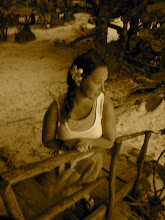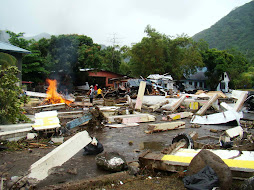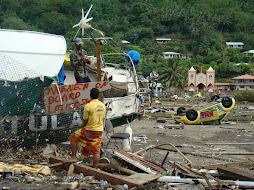Raj Borsellino: World Teach Volunteer, Leone High School Teacher, Village of Leone
The Day I'll Never Forget: Tuesday, September 29th, 2009
I’ve heard from a lot of people today who want to make sure that I’m okay following the earthquake and tsunami in American Samoa today. So I figured I’d tell my story. This was pretty hastily written, so cut me some slack.
A little bit of background: I graduated from college in May and decided to hold off on going straight to law school. After the tragedies that I’ve had to deal with during the last few years, I decided that I needed to get away from the hustle and bustle of my normal life. So me and Kelly, my girlfriend of four years, found a program called WorldTeach that would allow us to work as abroad volunteer full-time teachers. We decided to put our lives on hold, pack up our belongings, and move to American Samoa, a tiny island in the South Pacific, where we would teach public school for a year.
I’ve been in American Samoa for a little more than two months and I love it. I teach High School English in a small, tightly-knit village called Leone. It’s a deeply-religious community with an incredibly strong work ethic. Six days a week, everyone works tirelessly. They attend work or school, come home and clean the house do their other chores, and prepare for the next day. On Sundays, the entire village shuts down and everyone attends church, which is followed by a big feast called an umu. Everyone knows your name and waves at you when you walk by. I have a hundred and fifty students who come through my classroom every single day, but as an American living in a small Samoan village, it’s impossible to remain anonymous around here.
Flash forward to this morning, September 29th, the thirty-sixth day of the school year. I woke up at 6:47. Kelly came into the bedroom and jumped on me until I finally got out of bed. I wasn’t particularly excited about yet another school day, but I knew that I didn’t have much of a choice. As soon as I stood up and put on my glasses, I began to hear a loud noise and feel the ground shake. It’s the type of feeling that you might get when there’s an extremely powerful windstorm that rattles your house. But it kept getting worse. I had never been in an earthquake before, but it wasn’t difficult to tell that this was one. To be honest, I really had no clue what to do when I realized that I was in the middle of an earthquake. Neither did Kelly or Tanne, our other housemate. First we sat in the living room and ducked down, covering our heads. But then we got worried that the house would collapse, so we decided to go outside. As soon as we got out, we heard someone yelling something in Samoan at us, and since we couldn’t understand it, we assumed that they were telling us to go back inside. So we did. We spent the rest of the earthquake standing in doorways and hoping that nothing fell on us. About two minutes after it started, the earthquake was over. We looked around the house and surveyed the damage: a large mirror was broken in our bedroom, but other than that, everything was fine.
Since I had never been in an earthquake before, I had no idea that this was an abnormally large one. I assumed that we would go through the rest of the day as normal and maybe I’d have an interesting story to tell to my friends back home. Tanne caught a bus to school while Kelly and I finished up getting ready and then headed out for another day. When we walked out, there was a mass exodus of kids walking in the opposite direction. They told us that school was cancelled because of the earthquake. I called my family to let them know that I was okay, assuming there might be some minor blip on the news about a small earthquake in the South Pacific. I was mostly just excited that I had the day off from school. I had no idea that the earthquake was powerful enough to trigger a tsunami, nor did I even begin to consider that lives may be at risk.
Kelly and I stayed in the house for a while, even though our electricity and water had gone out. After a few minutes we looked outside and saw droves of schoolchildren and cars going inland. We thought that we would be okay where we were, so we stayed back. But then we found out from some kids walking by that a tidal wave had struck a few blocks from us and there was possibly another one on the way. A friend of a friend decided that we weren’t safe where we were, so he got in his truck and drove halfway across the island to pick us up. We packed up our belongings and headed to the top of one of the large mountains on the island. The further we got up the mountain, the more people we began to see. There were thousands of people on the side of the road, many of whom had thrown whatever they could grab into their suitcases and headed as far inland as possible. I noticed a lot of my students along the way, although they didn’t seem as happy and cheerful as usual.
Eventually, the warning for the second tsunami was called off and we were allowed to go back home. It was the middle of the day at that point and I still didn’t realize how bad of a disaster this had been. I went back home and decided to call my family back home to let them know that I was safe.
In the afternoon I was feeling restless and curious, so I decided to go into the center of my village, which was a short walk towards the beach. I’ll never forget the scene that I saw there. It was an absolute disaster area. There were completely empty spaces where houses used to be. Heaps of concrete and brick and tin piled all over the area. Trophies and family photos and children’s toys were strewn all about.
While I was walking I ran into Miracle, one of my sophomore students who always a smile on his face. Miracle is the type of student every teacher loves to have: he comes to class on time, always does his homework, participates in discussions, and always tells a good joke when the class needs one. He’s also a popular kid and one of the stars on the JV football team. But when I saw him today, his smile was gone. So were his house and all of his belongings. He had been home when the tsunami struck, and the wave smashed him through the window and out of his house. He only survived because he was able to hold onto his older sister the entire time the wave came crashing in. Considering what could have happened, he was actually quite lucky: he emerged with some bad cuts on his legs, a bloody lip, and scratches all over his chest. But everything in his house was gone. He lost an uncle. His sister had both of her legs crushed. And even though it was ten hours after the tsunami struck, his best friend (another one of my students) was still missing. He feared the worst.
As I walked around, I kept hearing more stories of lives that had been lost. There was the little girl who was swept out to sea, the boy who was crushed against the concrete wall, the old woman who didn’t even survive the earthquake. There were already six confirmed deaths in my village, but there are at least ten others who are missing and more than likely didn’t survive. Most of the deceased haven’t been named yet, but I can guarantee that some of them go to the schools where Kelly and I teach.
The schedule from here is unclear. For my friend Sarah, whose entire school was destroyed, it’ll be months before things can be cleared out and rebuilt. Kelly and I made it out relatively lucky: there was no damage to our house from the earthquake, and we were far enough inland that the tsunami didn’t reach us. There was no structural damage at
our schools.
We’re supposed to report to school at 8:00 tomorrow morning, where we’ll have an assembly and then be dismissed for the day. But I can’t even imagine walking to school tomorrow morning and finding out which of my students didn’t make it. The young kids who woke up this morning hopeful and excited for another school day and were killed by a
natural disaster that none of us can even begin to fathom.
I woke up this morning wondering how I was going to keep my hundred and fifty kids entertained and excited for the day. But I go to bed wondering how I, as an English teacher, can convince these children not to give up hope when they’ve lost their homes, their family members, and their fellow classmates. Even now, sixteen hours after that earthquake struck, I can still feel the tremors in my head and throughout my body. And I have a feeling that they’ll never leave me.
Tsunami: The Aftermath: Sunday, October 4th, 2009
It’s amazing how the last six days play out in my head. The earthquake and tsunami of Tuesday morning are still as crisp and clear as ever: the shock, the terror, and the destruction. But everything after that remains an amorphous blur. It’s all running together. I’ll try to put the events of the last few days in chronological order, although it’s not easy.
When I walked into town on Tuesday afternoon, the day the tsunami struck, I took some pictures of the damage to post on Facebook so everyone back home could see what had happened. Before I went to bed that night, I sent in a few pictures of the destruction to Reuters and the Associated Press since they both needed photos. Wednesday morning was a shocker. I woke up and checked Google news and the New York Times, as I do every morning. But on Wednesday, all of the news stories centered on my island, particularly my village. And even more stunning, the pictures that I had taken and sent in were on the front pages of all of these websites. They were in countless different languages in hundreds of different newspapers and websites around the world.
Twenty-four hours can be a lifetime. On Tuesday I was getting ready for another school day in my small town in my tiny-dot-on-the-map island, and the next morning my devastated village was the center of the entire world. It was wonderful to get kind letters from so many people that I haven’t talked to in a long time, but of course it was under such tragic circumstances.
The recovery efforts here have been getting stronger by the day, although they’re incredibly frustrating. On Tuesday, everyone was still in shock. On Wednesday and Thursday, rescue teams were still looking for bodies so there wasn’t much work for anyone else to do. But now, six days after the tsunami struck, I still can’t believe how little work there has been for us to do here. Some of the other American teachers here have spent countless hours sitting in the waiting room at the local Red Cross chapter trying to find something that they can help with. Most of them ended up going home hopeless and dejected. Kelly and I walked through the village again and again to see if there was anything we could do, mostly coming up empty-handed. A lot of the folks who had lost their homes weren’t allowed to begin tearing anything down until FEMA came in and took pictures of the wreckage.
That’s not to say that we haven’t been blessed with loads of help from the rest of the world. The US has sent in folks from AmeriCorps, the Red Cross, the military, and FEMA, along with countless other organizations. They all seem to know what they’re doing, but they don’t seem to rely very much on volunteers from within the community. As bad as things were on Tuesday, the frustration of living and working here and not being able to help out as much as possible has made things here even more difficult during the last few days.
On Friday, after deciding that we were tired of waiting for instructions, Kelly and I put on our gloves and ventured out into the shallow part of the ocean to start picking up the hundreds of pieces of debris that was there. There was everything from washing machines to microwaves to children’s toys to clothing to shoes to pots and pans. There were huge pieces of sheet metal that used to be the roofs of people’s homes. Within an hour, there were more than a dozen of us racing against the incoming tide and sorting through the trash to put it in a giant pile to burn. It was so painful to watch those tattered clothes and broken appliances go up in flames. People had spent years and years saving up for some of these things, but it was all washed way while folks were struggling mercilessly to hang onto their lives.
Amazingly, it appears as though all of the kids at my high school survived. Scores of them are now homeless and some even lost siblings and parents, but somehow the students all made it. Unfortunately, Kelly’s school (the elementary school) was not so lucky. One of her fellow teachers died, as did several students. Perhaps most tragic was the first grader who got to school early on Tuesday and was told to go back home after the earthquake hit. The tsunami struck during his walk home and his body still hasn’t been recovered.
One of the stories that hit closest to home was about Tita, the young teacher who shares a fourth-grade classroom with Kelly. When Kelly first arrived at school in early August, Tita was the one person who made sure everything was okay. She brought us movies and food and gave us rides to and from school. A few days before the tsunami hit, she stopped by our house to give us a brand new printer so we could make worksheets for our students. Tita’s house was directly in the tsunami’s line of fire, and although she survived, she lost absolutely everything. Her live-in babysitter was killed. Her house was in tatters. She couldn’t even begin cleaning up the wreckage two days later because FEMA needed pictures of her destroyed house and her camera was lost in the tsunami.
We have our first day back at school tomorrow, and I’m still not completely sure how to approach the tragedy with my students. We can’t just go back to learning about theme and characterization as if nothing happened. I thought about spending the first few days just talking as a class about what everyone had to go through. But aside from the notes they write to me in their journals, many of the students here are uncomfortable talking about anything related to their personal lives. It’s not easy to get anyone to open up about something so tragic and so personal, much less teenagers who are already struggling to come into their own. I also considered having my students write grant letters to corporations and foundations in the United States to ask for donations. But it may come across as somewhat demeaning to make these kids pour their hearts out to anonymous, nameless donors whose mercy they’re being forced to depend on. Maybe I’ll just give the kids word searches and let them talk amongst themselves for a day or two so the transition will be easier. I really don’t know what to do. If anyone has any ideas, I’d love to hear them.
This theme of uncertainty has been ringing in my head over and over during the last few days. Through the first seven weeks of school, everything here seemed so routine. I was finally starting to get a sense of the island and the culture. I felt like an outsider who was starting to be let in. Leone was becoming my village. And now, without warning, we’re all thrown into a much more intense situation, one that none of us knows how to deal with. Unlike the struggle of adapting to a new village and a new culture, this is a struggle the entire island is facing. Our students see us teachers as leaders and we’re supposed to provide certainty and confidence in times like this. It’s not a simple task.
One last thing: a lot of kind folks back in the states have been writing to ask if there’s anything they can do to help. To be honest, I’m not completely sure yet. I know that we'll need school supplies (backpacks, pencils and pens, notebooks), but I’ll get a much better sense of where my students’ lives stand when we return to school tomorrow. But I can assure you that absolutely anything will help, whether it’s clothing, cookware, electronics, etc. There are so many people who are left with absolutely nothing. It’s not going to be an easy recovery.



